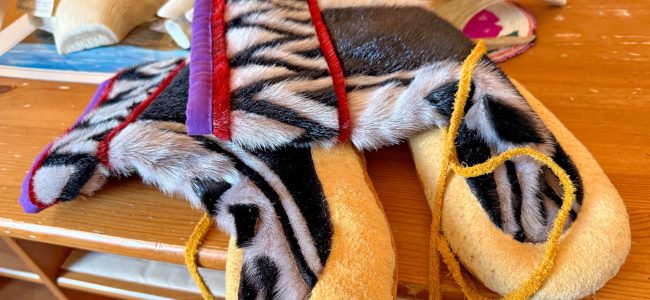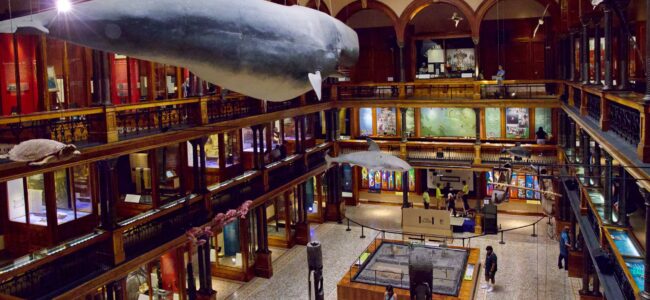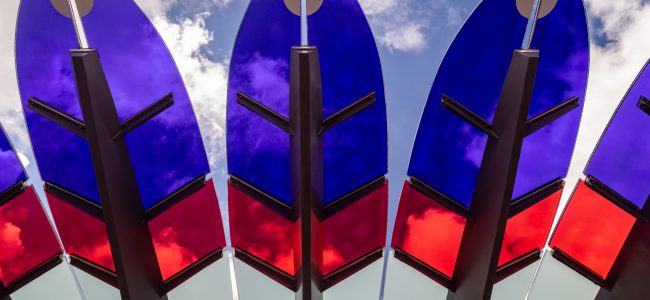August 3, 2025 – Inuvik to Tuktoyaktuk, Northwest Territories
2025 Yukon & Northwest Territories
Today, our group visit Tuktoyaktuk and the Arctic Ocean, and have a scenic flight over the Mackenzie River delta.
We are split into two groups, with my group leaving in the morning for Tuktoyaktuk on a touring van driven by our guide Olaf. This is the northern section of the Dempster Highway, some 150 kms of gravel from Inuvik. While in Tuk, we have an opportunity to take a dip in the Arctic Ocean and have a cultural visit before flying back to Inuvik over the beautiful Mackenzie River delta.
The other half of our group flies to Tuktoyaktuk later in the afternoon, visits Tuk, and returns by road in the evening.
Drive to Tuktoyaktuk
This most-northerly section of the Dempster Highway is 150 kms long and originally cost $300 million to build on the tundra and muskeg. Maintenance and rebuilding is done each summer, since the roadbed is built on such a soft foundation. At its highest point the highway is 550 metres above sea level. Locals stash snowmobiles and other camp equipment just off the highway and use the snowmobiles in the summer to cross the tundra to seasonal camps. We pass many lakes and bogs along the way, including Jimmy Lake, where a huge reindeer herd lives during the winter. Pingos are visible here and there – hills formed from the melting and freezing cycle, with their cores being permafrost.

Tuktoyaktuk
After making use of the washrooms at the Tuk airport, we drive over to Roger and Winnie’s home for an Inuit cultural experience. Winnie has prepared lunch for us: Cranberry jam on Bannock and Doughnuts to start; Reindeer soup; Whitefish and Arctic Char; and Cloudberry compote on confetti cake for dessert.
Roger shares with us his life in the north. Food comes from hunting, fishing and whaling (Beluga). Living in freezing temperatures most of the year means wearing parkas, mittens and boots. Winnie and Roger first met at a residential school. Roger was a leader for his people’s self-government and land settlement initiatives. Food is stored in permafrost root cellar lockers – a community resource.

Our next activity is to take a dip in the Arctic Ocean – a bucket list item for many in our group. This will likely be the furthest north (69º 27′ North Latitude) any of us will be while on land, so this is the time for selfies beside the shore of the Arctic Ocean, and dipping toes into the water, with a few in swimsuits going full immersion! On our way back to the airport, we stop for photos of two nearby and large Pingos in the Mackenzie River delta.

Sightseeing Flight over the Mackenzie River to Inuvik
- Our sightseeing charter flight departs from Tuk airport at 3:30pm on a De Havilland Canada DHC-6-300 Twin Otter
- Altitude – 150′ to 1,000′
- Fly along the Arctic Ocean coastline, circle some Pingos, and fly low over the intricate channels, pools and islands of the Mackenzie River delta
- Arrive in Inuvik at 4:30pm
For me personally, this sightseeing flight is the highlight of the tour, and the weather was perfect!
After our return to Inuvik, some of us have dinner at Alestine’s – a casual restaurant built in the owner’s front yard, with the kitchen inside a converted school bus. I enjoy some excellent fish tacos & Yukon Gold beer on the patio. Cost for me was $45 (tax and tip included, cash only). Very good service and food – highly recommended!
















































